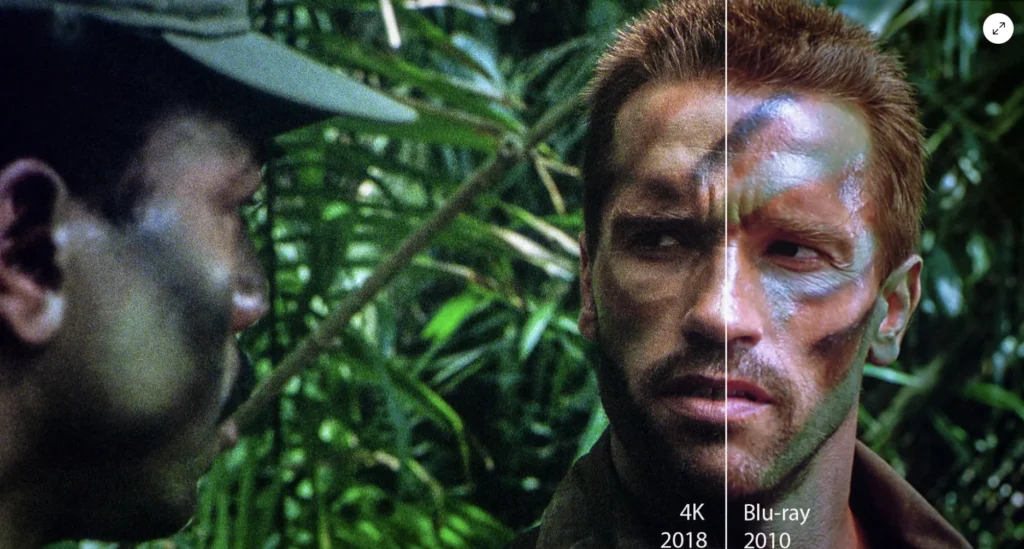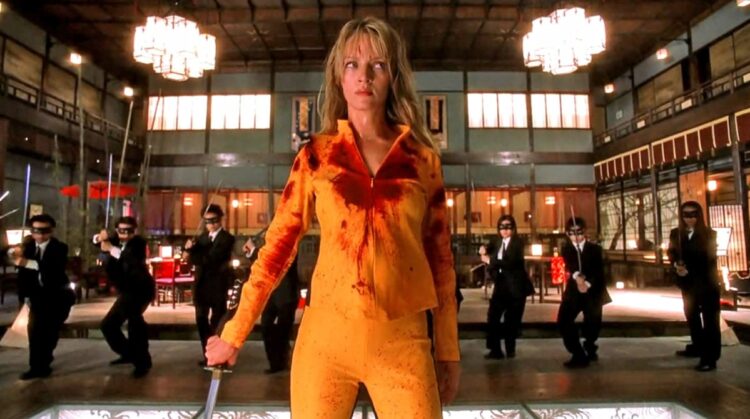Film grain or granularity is the random physical texture made from small particles of silver halide–the primary photosensitive substance used in chemical film–found on processed photographic celluloid. It is a result of those particles reacting to the light.
Grain looks like tiny particles randomly swimming around on an image, almost like a faint veil of static or sand dancing over the image. Each frame of a movie shot on film stock contains thousands of these tiny, unpredictable dots. These can vary in size, not just because of their random nature but also by the size of the image shrinking or the grains increasing. As filming techniques and equipment developed, the particles were engineered to be less visible and smaller in size.
Film grain gives a lived-in, weathered, and textured look in films and photographs. It can be used for stylistic effect like many other photographic and video techniques. This can be confused with film “noise” but the two are very different. Film noise are the scratches, specks, hairs, and random imperfections that affect a physical print over time. It’ll be most clear during the opening and closing parts of a reel where it gets spliced together. These quick, sputtering specks often indicate that the reel has ended or is beginning. In a pristine restoration of a movie shot on film, the grain would still be visible, but the noise would be removed.
In present times, almost every piece of visual media is digitally shot. The priority now is “clean” images and both, the visuals and sound have become high-definition. The media we consume is near flawless when it comes to resolution and image clarity. Digital cameras eliminate film grain as they do not make use of film shot on photographic celluloids. They are also cheaper than film, providing razor-sharp visuals and post-production editing options to make changes after filming is done. There is a perception that modern movies look a little too clean or fake. This stems from a combination of technological advancements, lighting choices and a reliance on visual effects. The technically perfect images appeal to some, others feel they lack the emotional depth and authenticity that audiences crave, and feel flat.

Ironically, now that digital filmmaking has nearly perfected the “clean” image, some filmmakers are adding the film grain texture in post-production using software or filters. Film grains have transcended beyond being seen as flaws in an image that need to be minimised or removed and have many advantages. Filmmaker Nick Escobar says “The more we get to a clean digital world, the more we long for analog things that make us feel a sense of texture and connection.” Adding grain is never a random decision. The textured look of cinematic film grain is what adds personality, depth, and dynamics to celluloid film. It is often a deliberate stylistic choice in order to set the tone, mood, or even to increase the emotional appeal of the narrative to the viewer. It does something that ultra-HD clarity can’t, which is to introduce imperfection, and with it, emotional texture.
Grain breaks the sterile look of digital film by lightly softening the image. It enhances the 3-D-ness in a frame, allowing the foreground, mid-ground, and background to stand out from each other. Ultimately, It creates a sense of realism or nostalgia, or both. The unpredictability and randomness of grain makes films less engineered, and more human. A scene can feel distant if it is too clean or perfect. Film grain can help bridge the gap between the audience and the screen. It invites the viewer to lean into and feel the world of the film. That’s why directors across diverse genres still embrace it. It allows a director to transport the audience into a specific time, emotion, or mental state. If a film is set in the 20th century, grain texture could help set the tone better than a straight digital look would. Additionally, grain can add an otherworldly texture to the images.

For instance, Saving Private Ryan, Steven Spielberg’s World War II epic, opens with a chaotic and gut-wrenching portrayal of the D-Day landing. The heavy use of grain, along with the desaturated colours and handheld camerawork, brings palpable realism to the scene. It immerses the viewer in the movie. The grain adds a harsh texture to match the brutality and violence of war, making the movie not only real but also emotionally exhausting in the best way.
In contrast, Todd Phillips’ Joker, a film shot digitally but made to feel like a 1970s psychological drama used grain more subtly, layering it in during post-production to evoke the feeling of older cinema. It gives Arthur Fleck’s world a sense of decay, the city itself seemed to be deteriorating along with him. The addition of the grain makes the viewer feel slightly uncomfortable—as if they were being made privy to something they weren’t meant to witness. In both films, the grain is a thematic choice, not merely aesthetic.
The choice of grain speaks volumes about a filmmaker’s vision and style. It’s a subtle nod to the emotional and historical layers of cinema, a reminder that not everything needs to be polished to be powerful. Imperfection is a big part of our daily lives and our human experience. There is power in letting it live in our films. It often makes them real and raw.


